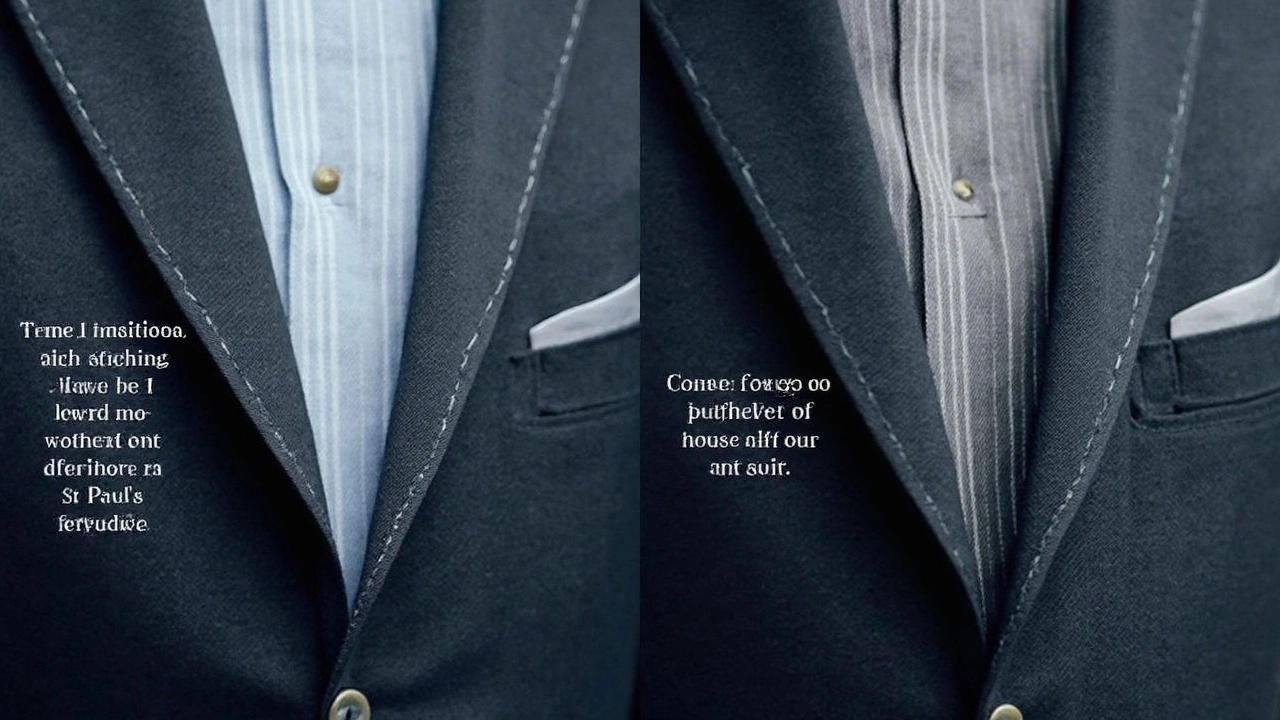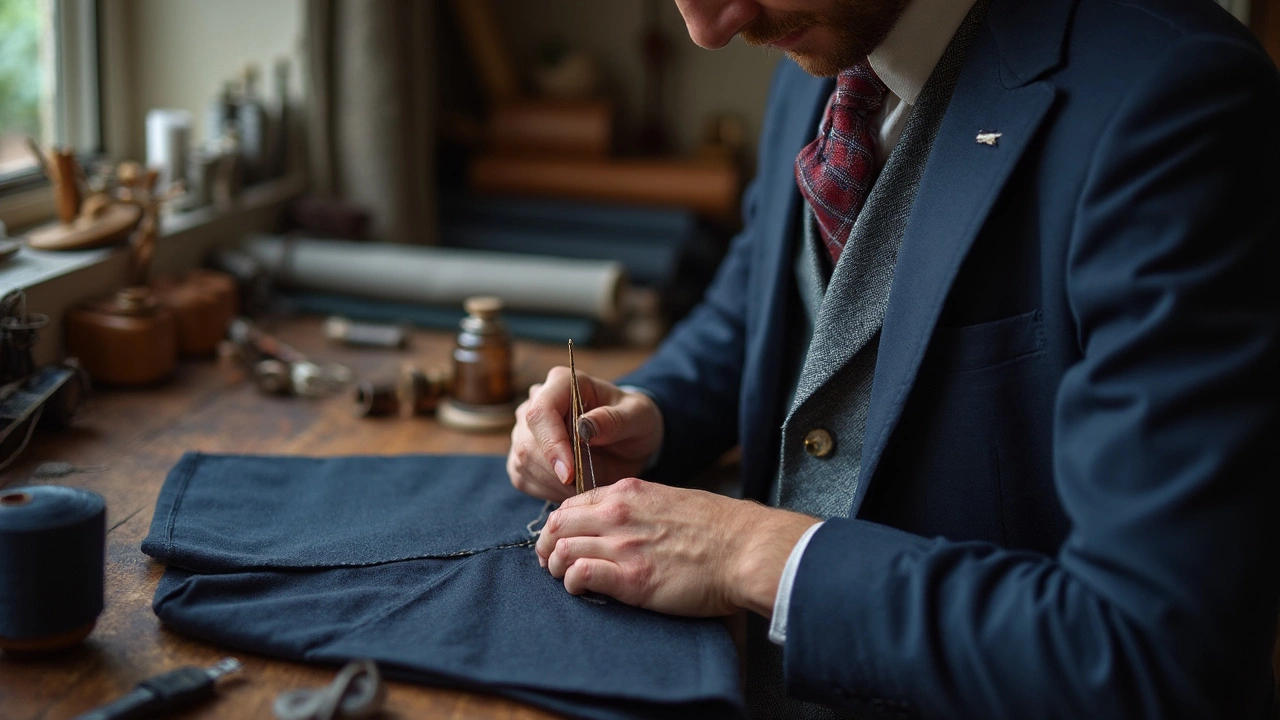Can a tiny detail make or break your suit game? You wouldn’t think something so small as a little row of visible stitches would matter, but in the world of men’s suiting, debates about pick stitching are surprisingly heated. Some swear by this subtle craftsmanship, insisting it’s the easiest way to turn a bland jacket into a showstopper. Others scoff, dismissing it as nothing more than decorative fluff. So, should you actually care about pick stitching—should you ask for it on your next suit, or just let it be?
What Exactly Is Pick Stitching?
Picture this: you walk into a high-end tailor’s shop, run your hand along the jacket lapel, and feel the tiniest, most deliberate bumps—little raised stitches running near the edges. That’s pick stitching. Unlike the invisible, cold precision of a machine, pick stitching is done by hand, one neat stitch at a time. Sometimes it’s barely visible; other times, it pops with a contrasting color, winking at fellow sartorial enthusiasts.
This isn’t some new Instagram trend. Pick stitching has been trusted by old-school Italian tailors and Savile Row masters since the early 20th century, showing up in suits worn by stars like Cary Grant and David Bowie. The handwork involved means pick stitching is still considered the calling card of a bespoke (read: totally custom) suit. For years, a well-trained eye could spot a stitched lapel from ten feet and know instantly: this suit didn’t come from a department store.
You might have seen machine-made alternatives. These stitches can sort of look similar if you’re not looking closely, but any tailor worth their salt will spot the difference. With hand-pick stitching, the silk or cotton thread sits just so—delicate, imperfect, almost a whisper. Machines make it more uniform, more rigid, and almost always too perfect.
Why does this level of detail matter? It’s all about signaling craftsmanship. It tells the world that someone spent time—not minutes, but hours—on your pick stitching. It’s like driving a car with hand-stitched leather seats. Not necessary. But it signals taste and attention to detail in a way nothing else can.
Craftsmanship vs. Fashion Statement
We get it—fashion can get a little high and mighty, but pick stitching is one of those things that holds real meaning among people who know their tailoring. The fashion crowd will tell you it’s about showing your eye for the finer things. But real old-fashioned tailors will argue there’s more to it than looks.
Pick stitching doesn’t just add flair. It can help hold the suit’s edges together and keep its shape as you wear it. Hand-stitching creates a tiny bit of subtle give, so your jacket lapel stays flat and doesn’t curl over time. Mass-market, fused suits often lack this, which is why they can start to bubble or lose their clean edges after a few months.
Even so, pick stitching has become something of a flex in the tailoring world. Some folks will pay to have it extra visible, using thicker thread or brighter colors as a bold statement. If you poke around a luxury boutique, you’ll notice these finishing touches are never loud or garish. The real trick—according to tailors in Naples and London alike—is subtlety. Any tailoring trick that says, “Hey, look at me!” tends to look cheap, not chic.
The conversation isn’t all stuffy traditions, by the way. Plenty of modern designers and celebrities are having fun with pick stitching now. Daniel Craig’s James Bond suits, custom-made by Tom Ford, sport a barely-there edge stitch, just visible enough to hint at top-shelf craftsmanship. But you won’t catch him rolling into a casino with yellow or purple pick stitching.
To put the tradition in context, here’s what the renowned menswear critic G. Bruce Boyer said:
“Pick stitching is like the chef’s signature on a dish; you may not notice it immediately, but once you do, you recognize real skill.”

Does Pick Stitching Really Make a Suit Better?
This is where things get interesting. Does pick stitching make your suit fit better or last longer? Well, not always. The stitch itself isn’t about structural integrity—it won’t prevent your suit from ripping if you’re rough on it. But it can stop the edges from looking floppy or unstructured, especially on lapels and pockets. If done by hand, it helps your suit “roll” naturally with your shape.
For those who geek out on suit construction: suits without pick stitching often use fusing or adhesive to keep the layers together. These will look crisp right out of the box but sometimes age poorly. Hand-pick stitching on a canvas-lined suit lets the fabric breathe and move. That means your jacket will drape better over your frame, even after years of wear.
Still, taste is personal. Some people want their suit to look flawless and immaculate—almost machine-made. Others like the story a few hand stitches tell. If you’re paying extra for a bespoke suit, you’re really after the feeling of something made for you, by someone, not something spat out of a factory. Pick stitching gives you that, even if only a few people ever notice.
Let’s keep it real: most folks on the street won’t notice your pick stitching. But those who do? They’ll know you value the same invisible details that mark out a proper, old-school, made-for-you suit. And that’s really the whole point.
To give a clear look at the differences, check out this comparison:
| Feature | Hand Pick Stitching | Machine Stitching |
|---|---|---|
| Appearance | Irregular, subtle, unique | Even, uniform, precise |
| Cost | High (labor-intensive) | Low (quick, automated) |
| Craftsmanship | Sign of bespoke tailoring | Standard/factory |
| Longevity | Edges are more flexible | Edges can stiffen, fray |
| Noticeability | Only to trained eye | Obvious when overdone |
Should You Ask for Pick Stitching On Your Suit?
This is where you have to do a little soul-searching. Are you the type who loves subtle flexes and hidden details? Then ask for pick stitching, but tell your tailor you want it subtle—close to the color of the suit fabric. If your vibe is more bold, experiment with a shade or two lighter (never neon, though—no, seriously).
For people on their first custom suit, I always suggest: ask your tailor to show you a swatch. Try jackets on that have pick stitching and some without. You’ll feel the difference not just in look but in the spirit. It’s a lot like picking between matte and gloss car paint—both work, but one says more about you.
There’s no real downside to pick stitching if you’re going bespoke or made-to-measure. On the other hand, if you’re buying off the rack, skip any suit with obvious or contrasting machine pick stitches. They’re trying to trick you into thinking it’s hand-made, but that’s a cheap trick, and those who know, know.
One pro tip: always check pick stitching on the lapels and pockets. These areas get the most attention and wear. A little extra handwork goes a long way toward keeping a suit looking sharp after dry cleaning and daily hustle. For those who really want to geek out, some exclusive ateliers let you choose the thickness of the thread so you can truly dial in your look.

How Pick Stitching Fits the Bigger Style Picture
Okay, so you’ve picked your suit, and you’re debating this last detail. Ask yourself: am I buying a suit to wow crowds, or just for the confidence boost it gives me? Pick stitching is about the invisible details—the finesse, the care, the “this was made for me” factor.
This isn’t just about what’s “in” right now. Fashion trends come and go, but the hand-sewn pick stitch is eternal. You’ll spot it on vintage Dior, on the lapels of Italian grandpas in family photos, and, lately, even on streetwear suits coming out of Tokyo. Some folks say only older gentlemen care, but more and more, professionals in their 30s and 40s—lawyers, creatives, consultants—are requesting hand-finished edges as a personal signature.
If you want your suit to stand up against mass-production and fast fashion, this is one of the last remaining marks of true craftsmanship. It’s an investment in both style and heritage. Sure, you could skip it and still look sharp. But when you want to take your suit from “good” to “memorable,” the details like pick stitching are where the magic hides.
So, next time you’re designing your perfect suit, take a second look at those tiny stitches along the edge. They might not shout for attention, but sometimes, the quietest statement is the one that sticks with you (and everybody else who knows their suits) the longest.

